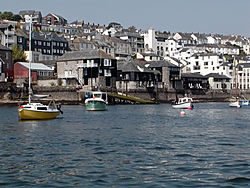Falmouth, Cornwall
Falmouth
|
|
|---|---|
 Falmouth Harbour |
|
| Falmouth shown within Cornwall | |
| Population | 26,767 (2011 Census) |
| OS grid reference | SW810325 |
| Civil parish |
|
| Unitary authority | |
| Ceremonial county | |
| Region | |
| Country | England |
| Sovereign state | United Kingdom |
| Post town | FALMOUTH |
| Postcode district | TR11 |
| Dialling code | 01326 |
| Police | Devon and Cornwall |
| Fire | Cornwall |
| Ambulance | South Western |
| EU Parliament | South West England |
| UK Parliament | |
| Falmouth Town Council | |
|---|---|
| Type | |
| Type | |
| Leadership | |
|
Mayor
|
Cllr Grenville Chappel
|
| Seats | 16 Councillors |
| Elections | |
| Multiple non transferable vote | |
|
Last election
|
2 May 2013 |
| Meeting place | |
| Falmouth Town Council, Municipal Buildings, The Moor, Falmouth TR11 2RT | |
| Website | |
| www |
|
Falmouth (/ˈfælməθ/; Cornish: Aberfala) is a town, civil parish and port on the River Fal on the south coast of Cornwall, England, United Kingdom. It has a total resident population of 26,767.
See also: Miss Susan Gay's Falmouth chronology
The name Falmouth is of English origin, which recent Cornish language enthusiasts have translated to "Aberfal" (or "Aberfala") based on Welsh precedents. It is claimed that an earlier Celtic name for the place was Peny-cwm-cuic, which has been Anglicized to 'Pennycomequick'.
Falmouth was the site where Henry VIII built Pendennis Castle to defend Carrick Roads, in 1540. The main town of the district was then at Penryn. Sir John Killigrew created the town of Falmouth shortly after 1613.
In the late 16th century, under threat from the Spanish Armada, the defences at Pendennis were strengthened by the building of angled ramparts. During the Civil War, Pendennis Castle was the second to last fort to surrender to the Parliamentary Army.
After the Civil War, Sir Peter Killigrew received Royal patronage when he gave land for the building of the Church of King Charles the Martyr, dedicated to Charles I, "the Martyr".
...
Wikipedia

